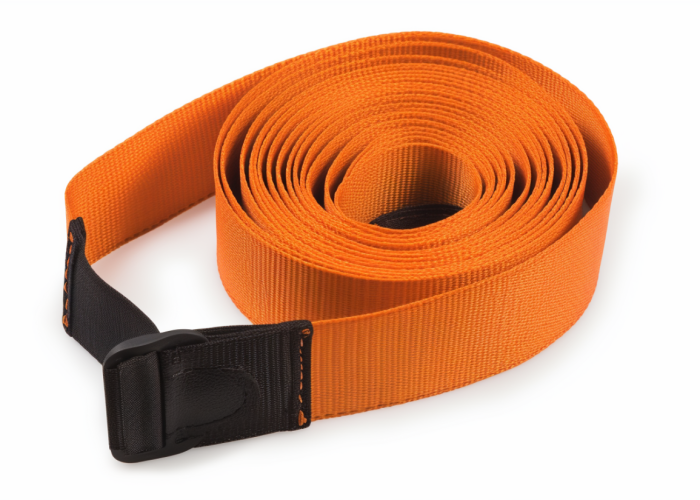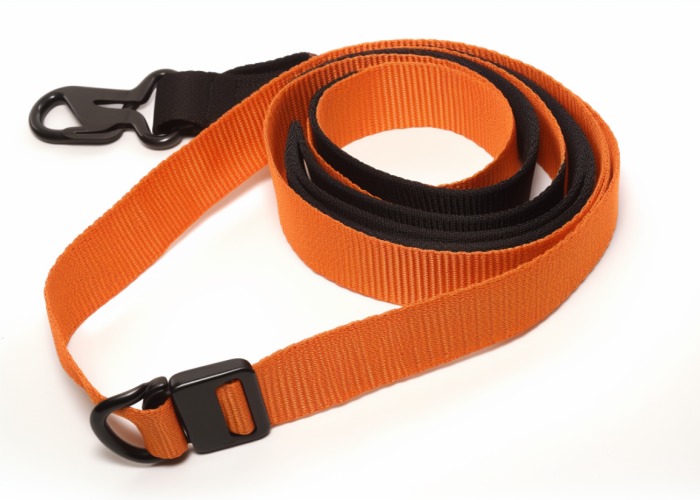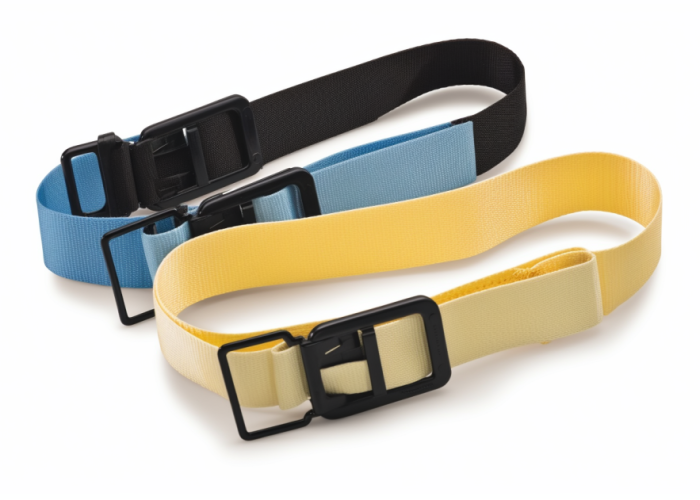Selecting the proper positioning strap material directly impacts product safety, performance, and durability. Understanding key differences between nylon and polyester helps engineers make informed design decisions. As a specialized webbing manufacturer, we create custom solutions with precise specifications for flexibility, strength, and environmental resistance tailored to your exact application needs.
Nylon and polyester positioning straps differ primarily in stretch properties, moisture resistance, and UV stability. Nylon provides excellent flexibility (20-30% elongation) and shock absorption, while polyester offers minimal stretch (2-3%), superior UV resistance, and better dimensional stability in wet environments. Each material serves distinct applications based on environmental exposure and performance requirements.
Discover key performance factors for choosing the right webbing for positioning straps—based on application needs, industry standards, and environments.


Webbing manufacturing expert with 15+ years of experience helping product developers build high-performance straps for industrial, medical, and outdoor use.
Polyester positioning straps offer superior compression resistance compared to nylon, maintaining their original shape and structure even under sustained pressure. This difference stems from polyester’s more rigid molecular structure and lower elasticity, making it ideal for applications where dimensional stability is crucial, such as medical patient positioning or equipment securing.
Key Compression Performance Factors:
Nylon’s molecular composition includes amide groups that allow for flexibility but compromise compression resistance. When subjected to sustained pressure, nylon straps can develop permanent deformation at stress points, particularly with irregular shapes or focused pressure points.
The compression difference becomes particularly evident in high-temperature environments, where nylon’s resistance decreases by approximately 15-20% compared to ambient conditions. In contrast, polyester maintains consistent performance across a wider temperature range, with minimal degradation up to 150°F.
Manufacturing techniques can enhance compression resistance in both materials. Heat-setting processes during polyester webbing production increase compression resistance through molecular realignment. For applications requiring maximum dimensional stability, higher denier count and tighter weave patterns significantly improve performance while maintaining necessary tensile strength.
For positioning applications requiring extended use under constant pressure, polyester’s superior compression resistance translates to longer service life and more consistent performance, typically maintaining dimensional stability 3-4 times longer than comparable nylon straps under identical conditions.
Property Nylon Webbing Polyester Webbing
Compression Resistance Moderate (70–75%) Excellent (95–98%)
Temperature Impact High (15–20% decrease at 150°F) Low (3–5% decrease at 150°F)
Recovery After Load 85–90% recovery 97–99% recovery
Deformation at Stress Points Moderate to High Minimal
Service Life Under Constant Load 1x (baseline) 3–4x longer
Polyester positioning straps provide superior long-term durability compared to nylon in most environments, particularly when exposed to moisture, UV light, and continuous strain. With approximately 20-30% greater abrasion resistance and significantly better UV stability, polyester webbing typically offers a service life 2-3 times longer than comparable nylon products in outdoor or high-wear applications.
Key Durability Factors:
Nylon’s primary durability weakness stems from its hydrophilic nature, absorbing 6-8% of its weight in water, which temporarily plasticizes the polymer structure. This moisture absorption reduces breaking strength by 15-20% and accelerates wear at contact points, particularly in applications with repeated wetting and drying cycles such as marine environments or outdoor medical equipment.
UV degradation represents another significant durability differentiator. Nylon webbing exposed to direct sunlight can lose 40-60% of its tensile strength within one year of continuous outdoor exposure. Polyester, with its superior UV resistance, typically maintains over 90% of original strength under identical conditions, making it the preferred choice for long-term outdoor positioning applications.
Manufacturing techniques significantly impact durability for both materials. Heat-stabilized nylon and UV-resistant treatments can extend service life by 40-50% in challenging environments. Similarly, specialized coatings can enhance abrasion resistance for applications involving continuous movement or contact with rough surfaces.

Specialized positioning strap materials become necessary when standard nylon or polyester cannot meet specific performance requirements related to fire resistance, biocompatibility, antimicrobial properties, or extreme environmental conditions. These specialized materials ensure compliance with industry-specific regulations while delivering enhanced safety and performance for critical applications.
Key Specialized Material Applications:
Medical and surgical environments represent the most demanding applications for specialized positioning straps. For these uses, materials must meet rigorous requirements beyond basic mechanical properties. Latex-free materials are mandatory in modern healthcare settings to prevent allergic reactions. Additionally, antimicrobial treatments that inhibit bacterial growth are increasingly required for infection control protocols, particularly for straps used in long-term patient positioning.
Fire safety represents another critical specialized requirement. In occupational safety applications, positioning straps often require fire-resistant ratings to comply with NFPA standards. These specialized materials maintain integrity at higher temperatures and resist ignition, providing crucial additional evacuation time in emergency situations.
For surgical environments, specialized materials capable of withstanding repeated sterilization cycles are essential. These materials must maintain structural integrity after exposure to steam autoclaving (typically 270°F at 30 psi) without degradation of mechanical properties. Specialized high-temperature polyesters or proprietary blends are typically required to meet these demanding specifications.
Biocompatibility testing according to ISO 10993 standards is mandatory for materials used in direct patient contact, particularly for extended periods. This specialized testing ensures materials do not cause cytotoxicity, sensitization, or irritation, requiring specialized formulations free from harmful additives or processing agents.
Manufacturing techniques significantly impact positioning strap performance through specialized weave patterns, heat-setting processes, and material treatments that enhance specific properties. Advanced manufacturing methods can increase tensile strength by 25-40%, improve dimensional stability, and add specialized performance characteristics while maintaining the base material advantages.
Key Manufacturing Enhancements:
Weave pattern selection represents one of the most significant manufacturing variables. Tubular-woven webbing typically stretches 5-8% less than flat-woven webbing of identical width due to its closed construction distributing tension more evenly. Herringbone patterns provide more controlled stretch while maintaining similar breaking strength, making them ideal for applications requiring predictable elongation characteristics.
Heat-setting processes during manufacturing permanently align the molecular structure of synthetic fibers, significantly enhancing dimensional stability. This treatment is particularly valuable for polyester positioning straps, reducing potential creep under sustained loads by 25-30% and ensuring more precise positioning in critical applications.
Specialized coating applications can dramatically enhance environmental resistance properties. Silicone-based coatings improve temperature resistance, while fluoropolymer treatments create chemical-resistant barriers for industrial environments. These coatings can be precisely formulated to maintain flexibility while providing targeted performance enhancements.
Manufacturing precision regarding dimensional tolerances directly impacts performance consistency. Advanced manufacturing techniques maintain width tolerances within ±0.5mm and thickness variations under 5%, ensuring consistent performance across production lots—a critical factor for safety-critical applications like medical positioning or fall protection.
Manufacturing Technique Performance Enhancement Typical Applications
Tubular Weaving 15–20% strength increase, reduced edge fraying Medical restraints, safety harnesses
Jacquard Patterns Custom stretch zones, improved grip Patient positioning, equipment securing
Heat-Setting Enhanced dimensional stability Surgical positioning, precision applications
Antimicrobial Treatment 99.9% reduction in bacterial growth Long-term medical positioning
UV-Resistant Coatings 200–300% increase in outdoor lifespan Outdoor safety applications
Different industries require specific positioning strap materials based on their unique performance requirements and operating environments. Nylon excels in applications needing shock absorption and flexibility, while polyester dominates environments with moisture exposure, UV radiation, or requirements for dimensional stability.
Key Industry Applications:
The healthcare industry predominantly utilizes polyester positioning straps due to their superior compression resistance and dimensional stability. In surgical settings, precise patient positioning must be maintained throughout procedures, making polyester’s minimal stretch characteristics ideal. Additionally, polyester’s compatibility with sterilization procedures, including autoclave cycles, ensures infection control requirements are met.
Construction and occupational safety applications typically leverage nylon’s superior energy absorption characteristics. In fall protection systems, nylon’s controlled elongation (typically 15-20% at rated load) helps reduce impact forces transmitted to the user during fall arrest, potentially reducing injury severity. This controlled stretch represents a significant safety advantage over polyester’s more rigid performance (2-3% elongation).
Maritime and outdoor applications almost exclusively utilize polyester webbing due to its exceptional resistance to moisture and UV degradation. Nylon’s significant strength loss when wet (15-20%) and rapid UV degradation make it unsuitable for long-term marine applications, where positioning straps may remain installed for months or years in challenging environmental conditions.
Industrial manufacturing environments typically require application-specific material selection based on environmental exposures. Chemical processing facilities often require specialized chemical-resistant coatings, while high-temperature environments may necessitate flame-resistant treatments regardless of base material selection.
Industry Preferred Material Primary Performance Drivers
Healthcare/Medical Polyester (95%) Sterilization compatibility, dimensional stability, biocompatibility
Construction Safety Nylon (70%) Energy absorption, flexibility, shock-load performance
Manufacturing Environment-specific Chemical resistance, temperature stability, abrasion protection
Maritime Polyester (90%) Salt-water resistance, UV stability, minimal water absorption
Transportation Polyester (80%) Weather resistance, dimensional stability, long-term performance
Water and UV exposure significantly impact positioning strap longevity, with material selection being the primary determining factor for environmental resistance. Polyester maintains approximately 95% of its strength when wet and retains structural integrity under UV exposure for 3-5 times longer than nylon, making it superior for outdoor applications.
Key Environmental Resistance Factors:
Water absorption represents a significant differentiator between materials. Nylon absorbs 6-8% of its weight in water, causing temporary plasticization of the polymer structure and resulting in a 15-20% reduction in breaking strength. This property is particularly problematic in safety-critical applications where unexpected strength reduction could lead to system failure. Polyester, with water absorption under 0.5%, maintains consistent performance regardless of moisture exposure.
UV degradation follows a similar pattern, with nylon demonstrating significantly worse performance. Extended UV exposure causes polymer chain scission in both materials, but nylon degrades at a dramatically accelerated rate. Testing under standardized conditions (ASTM G154) shows nylon typically loses 50% tensile strength after approximately 200-300 hours of accelerated exposure, while comparable polyester retains 80-85% strength under identical conditions.
Combined exposure to both water and UV radiation creates particularly challenging conditions, with interaction effects accelerating degradation. In marine environments, nylon positioning straps may require replacement within 6-12 months, while polyester alternatives typically maintain acceptable performance for 3-5 years before requiring inspection or replacement.
Manufacturing techniques can significantly improve environmental resistance for both materials. UV stabilizers incorporated during production can extend service life by 40-60% in outdoor applications. Similarly, hydrophobic treatments can reduce water absorption in nylon, though they cannot completely eliminate this inherent material characteristic.

Selecting the optimal positioning strap material requires balancing specific performance requirements against environmental conditions and application demands. Whether you need nylon’s superior flexibility or polyester’s exceptional environmental resistance, our manufacturing capabilities allow us to create custom webbing solutions with precise specifications, specialized treatments, and application-specific performance enhancements tailored to your unique product requirements.
Positioning straps require visual inspection before each use and formal documented inspection annually. For safety-critical applications, implement quarterly inspections with detailed documentation. Straps showing visible abrasion, discoloration, stiffness, cuts, or deformation must be immediately removed from service regardless of inspection schedule to ensure operational safety.
OSHA Standard 1910.140 governs positioning straps for occupational safety applications, requiring a minimum breaking strength of 5,000 pounds. This standard mandates regular inspection by a competent person at least annually, with documentation of inspection dates and findings. Fall protection positioning devices must also meet specific connection and attachment requirements.
Medical-grade positioning straps must withstand facility-specific sterilization processes while maintaining structural integrity. Materials should tolerate steam autoclaving (270°F/30 psi), chemical disinfection, or ethylene oxide treatment without degradation. Polyester typically offers superior sterilization compatibility compared to nylon, withstanding repeated high-temperature exposure without significant property changes.
Medical positioning strap materials directly impact patient safety through biocompatibility, cleanability, and reliability factors. Materials must meet ISO 10993 biocompatibility standards to prevent skin irritation or allergic reactions. Polyester is generally preferred for its dimensional stability, antimicrobial potential, and compatibility with hospital disinfection protocols, reducing infection risks.
Polyester significantly outperforms nylon in high-moisture environments by maintaining 95-98% of its strength when wet. Unlike nylon, which absorbs 6-8% of its weight in water and loses 15-20% strength, polyester’s hydrophobic nature (0.5% water absorption) ensures consistent performance in wet conditions. This makes polyester the superior choice for marine, outdoor, or frequently cleaned applications.
Patient-contact positioning straps must undergo ISO 10993 testing to verify cytotoxicity, sensitization, and irritation safety. Materials should be latex-free to prevent allergic reactions and ideally incorporate antimicrobial properties for infection control. Manufacturing processes must eliminate harmful residual chemicals while maintaining appropriate material softness to prevent pressure injuries during extended use.